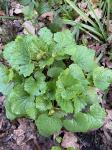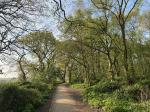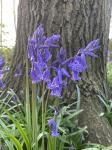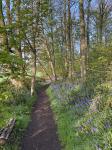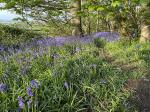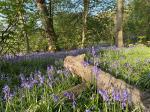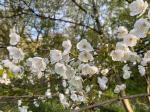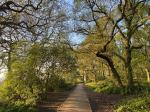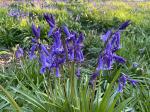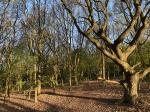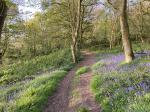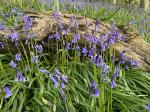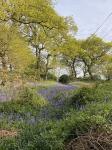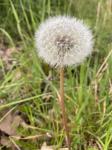Brayton Barff Through the Seasons.
Set in the Vale of York, South West of the market town of Selby and between the villages of Thorpe Willoughby and Brayton, lies Brayton Barff, a sandstone Hill approximately one hundred and fifty feet in height which was formed by glacial movement during the last Ice Age. It is a significant landmark in an otherwise flat landscape.
Today the site is primarily owned by Yorkshire Water with Selby District Council owning a small patch of the land adjacent to the A63 Selby bypass. A large underground reservoir occupies the centre of the site which delivers water to around 4.7 million customers throughout Yorkshire.
Within the Barff woodland over 40% of the trees are Sessile Oak which are generally found in semi natural woodlands in the north of the country. These trees are so called because its acorns are not held on stalks, like those of the English Oak (Pedunculate), but attached directly to the outer twigs. There are also several English Oak trees as well as some cross-hybrid oaks. These trees are known to support many species of flora and fauna, invertebrates, mosses, lichen and fungi.
During the Victorian times it is thought that the shipbuilders on the east coast would come over to the Barff for selected cuts of timber to build their sea going vessels.
The Barff also has a variety of other trees including Silver Birch, Beech, Sycamore, Holly, Rowan, Scots Pine, Alder, Hawthorne and European Larch. There are also several Yew, Willow, Hazel, Horse Chestnut and Wych Elm. As with similar woodlands there are a variety of bushes, including Honeysuckle, Elderberry, Gorse, Broom and Buddleia.
The history of Brayton Barff is quite vague, apparently during 1803 a beacon was lit on the Barff when the country was threatened with an invasion by Napoleon. In May 1935, to celebrate King George V's Silver Jubilee, a Bonfire was lit on the Barff as part of the celebrations.
Early issues of Ordnance Survey Maps dated 1903 clearly show a rifle range on the Barff, extending out to Mill Lane. During the 
Between 2001 – 2004 the A63 Selby bypass, 10km twin lane single carriageway was constructed which severed the South West corner of the Barff, adjacent to Selby Golf Course and resulted in a slight redesign of several holes on the golf course. Wooden fencing was erected as a result of this new road running alongside of the Barff and a footbridge constructed over the ‘new road’ following the line of the Bridal way which extends from Mill Lane. Around 2005/2006 a definite 2metre wide limestone aggregate footpath was laid forming a circular path around the outer edges of the woodland. This footpath is approximately 1.2 miles in length and takes about 30 minutes to circumnavigate at a leisurely pace.
In 2012 the Barff was declared an Ancient Oak Woodland and as such throughout 2012 and 2013 significant work had been carried out by the relevant agencies to cut and remove large swathes of non-native trees, creating at that time huge scars on the landscape. Some three years later the planting of the native trees have become well established and are flourishing. Ongoing maintenance work on the footpath around the bottom of the Barff was completed during the Summer of 2016.
A second phase of woodland maintenance commenced during the Autumn of 2019 with the removal of many old and diseased trees and the cutting back of the Gorse and Broom bushes, especially adjacent to the ‘bypass trail’, this work continued through till March 2020 with re planting continuing into April 2020.
Brayton Barff is a popular site for walkers and bird watchers alike and a path circling the outer perimeter of the Barff makes a pleasant thirty minute walk, giving views looking over towards Selby and the village of Brayton as well as the power stations of Drax and Eggborough..jpg)
For the early risers it is a great place to see some stunning sunrises over the villages of Brayton looking towards Drax Power Station, the same with the Sunsets looking over towards Eggborough and Monk Fryston.
The Barff changes with the Seasons and every visit can reveal something new, the woodland is a haven for wildlife. Records show that since 1982 one hundred and twelve species of bird have been seen in the woodland and at least 40 of those have bred here, including Tawny Owl, Buzzard, Green Woodpecker, Spotted Flycatcher, Goldcrest and Nuthatch to name just a few. On average over 70 species of bird are recorded each year. Further details of the bird life on the Barff can be found on the Brayton Barff Group Facebook page, especially the posts from Derek Cooper. Today ‘The Friends of Brayton Barff group’ led by Derek and a small team of volunteers help keep and maintain the cleanliness of the site as well as recording the wildlife and bird sightings.
The Barff is also home to fifteen different species of mammals, including Muntjac Deer, Pipistrelle Bat, Fox, and Field Vole.
Over eighty species of plant and wildflowers have been recorded, included Bee Orchid, Northern Marsh Orchid, Wood Anemone, Marsh Ragwort, Bluebell, White Bluebell, Bittersweet and Purple and White Foxgloves. Over twenty species of Butterfly have been recorded, including Marbled White, Brown Angus, Speckled Wood, Comma and Brimstone.
During the Autumnal months fungi thrives in this woodland environment, species including Fly Agaric, Beefsteak Tree Fungi, Chicken of the Wood, Sulphur Tufts, Stinkhorn, Ink cap, Puffballs and Hoof Bracket are just some of the many varieties that can be found here.
Click on the galleries shown below to expand the albums.
April 2022
Well, here we are as April comes to an end.
Just when you think our winter is over for 2022, we had a light overnight dusting of snow on the Barff at the beginning of the month followed by several overnight frosts which helped to firm up and dry out the muddy trails around the woodland. That said, April has been quite unsettled, the first week or so saw some extremely cold mornings, though by the middle of the month everything became more settled and for a couple of days over the Easter weekend, the temperature rose to between 18 – 20C, unfortunately this wasn’t to last and by the end of the month it became much cooler.
April is always a busy month on the Barff with lots going on. The flora and fauna have been shooting up all over the place and lots of our birds have been returning to nest amongst the woodland. Amongst our first Spring visitors were the Blackcap and Chiffchaff which can be heard around the main perimeter path.
Our wildflowers have been shooting up, the Bluebells started flowering within the first week of April and by the middle of the month were in flower in all the usual places, especially around the eastern side, and it looks to have been a good year for them, I even managed to spot lots of white bluebells this year. The Foxgloves have shot up this month and will soon be flowering. Wood Sorrel is beginning to flower, its tiny white bell-shaped flower flickering in the morning breeze. Lesser Celandine seems to thrive all over the perimeter path verges, its delicate little yellow star-like flowers with green heart shaped leaves, it is one of the first flowers to appear after winter and provide an important nectar source for queen bumblebees and other pollinators emerging from hibernation. Coltsfoot is spreading amongst the verges of the perimeter path, its sun-yellow, daisy-like, flower heads (made up to lots of tiny flowers) appeared in February, and provides lots of colour after the winter months, alas by the end of April the delicate yellow flowers have all but disappeared. Wood Anemones too have been flowering nicely, their star-shaped white petals, with a pink tinge cover the woodland floor and are a good indicator that we are in an ancient woodland.
The Easter weekend between the 15th to 18th April saw some of the warmest weather of the month, I was down in Kent at that time and on Easter Saturday the temperature reached 23C down there, whereas up north it reached a very pleasant 20C. It was nice to enjoy the warmer weather over the Easter period.
Having been quite dormant over the winter period, and after the warmer weather over the Easter holiday the butterflies have started to awake and stretch their wings, including the Brimstone, Peacocks, Small Whites and Orange Tips all regular visitors on the Barff, and can be seen on the freshly blossomed wildflowers.
I have seen several young Roe deer on the Barff throughout April, my first encounter was one Saturday morning in the field adjacent to Selby golf club along the Bypass trail, on the corner with Mill Lane, a young deer was running/jumping across the field which had been planted up with wheat, which at the time was a good two foot tall. I have also seen them grazing amongst the bluebells in the paddock of the old pumping station, several other people have also seen them at various locations around the woodland too.
The birdlife continues to flourish amongst the woodland and during the last few days of April Yellowhammer, Corn Bunting, Skylark and Whitethroats can be heard singing and chattering amongst the trees most mornings, as well as our resident Robins, Dunnock Chaffinch, Bullfinch, Great and Blue Tits and Nuthatches, though just recently as the month comes to an end, many of the birds have settled onto their nests keeping their eggs warm, I have certainly noticed how the Nuthatch in particular seems to have quietened down. The Greater Spotted Woodpeckers have been very active too and can be heard most mornings either drumming on the trees or alarm calling when someone unsuspectedly walks close to their nesting sight.
I still occasionally see and hear the Buzzard circle high above the woodland area and occasionally over the fields near the pumping station, I am pretty certain it has nested on the Barff this year, along with the Kestrel which can often be seen flitting in and out of the woodland.
As the month comes to a close, the Bluebells are looking really beautiful, although no two days are the same, on a dull, cloudy and overcast morning they look a lovely, a rich, vibrant blue colour, yet on a bright and sunny morning their colour seems to fade, and they appear much lighter.
I am pleased to note that one of our Tawny owls has just had chicks again this year, I occasionally hear it calling on my very early morning walks, I have yet to see it, though.
|

